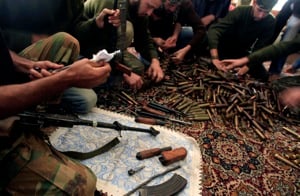BEIRUT — Syrian rebels stepped up their siege of a government helicopter base and clashed with soldiers near Aleppo’s international airport Friday in an effort to chip away at the air power that poses the biggest challenge to their advances against the regime of President Bashar Assad.
That airborne threat came into stark relief the same day, when a government airstrike on a northern town killed 14 people — most of them women and children, activists said. More than 21 months into Syria’s conflict, the Assad regime is counting more than ever on its air force to block rebel gains.
Rebels in the north, a region largely clear of government troops, realize this and have launched campaigns to seize all the area’s airports, hoping such a move will protect their forces and the civilians who back them.
Rebels say they have surrounded four airports in the northern province of Aleppo. In recent days, they have posted dozens of videos online showing fighters shooting mortars, homemade rockets and sniper rifles at targets inside the bases.
It remains unclear whether rebels will be able to seize any of the bases soon, but they have managed to stop air traffic at one and limit movement at others by firing on all approaching aircraft with heavy machine guns.
“The airports are now considered the most important thing the rebels can focus on because all of the strikes now come from the air,” said Aleppo activist Mohammed Saeed via Skype.
Saeed said clashes between rebels and government soldiers raged until Friday morning around the Mannagh helicopter base near the Turkish border. He said other rebel groups continued to hold positions around the Kuwiras military airport southwest of the city of Aleppo and clashed with soldiers near Aleppo’s international airport and neighboring Nerab military airport.
Rebels have numerical superiority and support from most of the population in the far north, making it easy for them to surround and cut the ground supply lines to government military bases.
But Assad’s forces still control the air, responding to rebel gains with airstrikes on their positions or residential areas, a tactic rebels consider collective punishment against civilians who back the revolt.
The rebels remain largely helpless against regime air power, and credible reports of them shooting down government aircraft are rare. But many groups now have heavy caliber anti-aircraft guns they say act as a deterrent to lowflying aircraft.
Activist Hazem al-Azazi said via Skype that rebels have surrounded the Mannagh airport near the Turkish border and have stopped helicopter traffic in and out of the base for about a week.
On Friday, a government helicopter tried to drop food and ammunition to troops in the base, but the supplies fell to rebels, he said. The day before, a group of rebels sneaked into the base and destroyed two tanks. One rebel was killed and four injured before they got out, he added.
The fall of any of Aleppo’s airports would give a psychological boost to the area’s rebels and give them greater freedom of moment since ground forces often shell from inside the airports.
It would not, however, stop the airstrikes, most of which are carried out by jets from the central province of Hama or near the capital, Damascus.
The airstrike Friday killed 14 people in the town of al-Safira south of Aleppo, activists said.
The town, frequently hit by airstrikes, sits next to a large military complex with factories, air defense and artillery bases. Rebels have been attacking the base for weeks, and activists say the regime has been striking the town in revenge.
The Britain-based Syrian Observatory for Human Rights said the dead included two women and eight children.
An Aleppo activist who spoke on condition of anonymity for security reasons provided names of the dead and said the town was hit because of the rebel attacks on the nearby base.
A video posted online that purported to show the site of the strike showed a large area covered with the rubble and the walls sheared off of a row of buildings nearby.
The video appeared genuine and corresponded to other reporting.
Activists also reported large clashes near Damascus and in the southern town of Busra al-Harir. They also said rebel forces seized the al-Tanak oil field near the Iraqi border to the east.
International diplomacy has failed to slow Syria’s crisis, which anti-regime activists say has killed more than 40,000 people since March 2011.
On Friday, Russia’s foreign minister said Moscow had proposed talks with the main Syrian opposition coalition, even though it has criticized Western countries for recognizing the group.
Sergey Lavrov told reporters that Russia has contacted the Syrian National Coalition for Opposition and Revolutionary Forces through the Russian Embassy in Egypt to suggest a meeting with coalition leader Mouaz al-Khatib.
Al-Khatib criticized the invitation.
“If we don’t represent the Syrian people, why is he inviting us?” he said in an interview with Al-Jazeera TV, calling Assad’s ouster “a main condition in any negotiations.”
“The Syrian people haven’t heard one fair word from Russia to the Syrian people, especially to the children, innocent people and civilians who are killed every day with Russian weapons,” he said.
Information for this article was contributed by Jim Heintz of The Associated Press.
Front Section, Pages 2 on 12/29/2012

